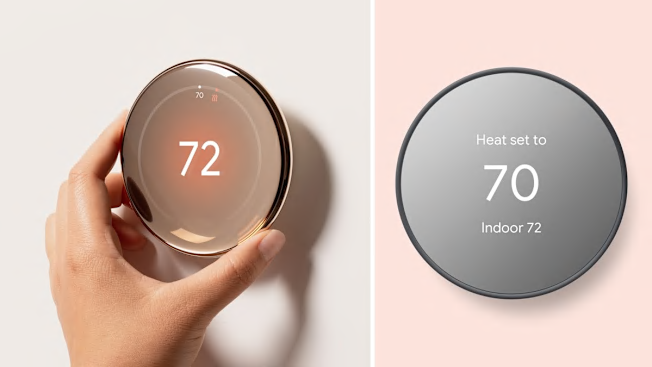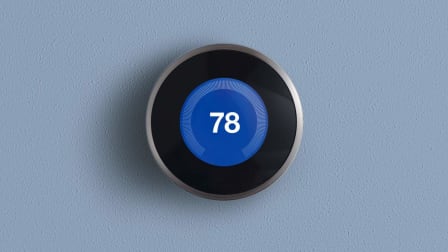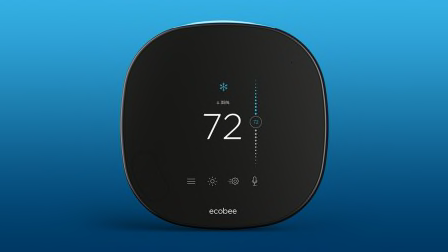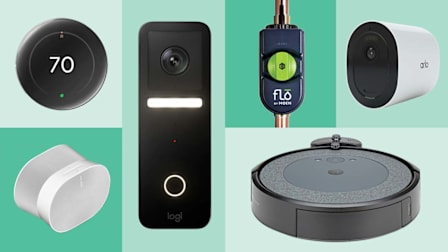Should You Buy a Google Nest Thermostat?
Nest's two smart thermostats look similar, but they're very different under the hood—and only one of them is a "learning" thermostat. Read CR's expert review for the real-world differences.

When it debuted in 2011, the Nest Learning Thermostat wasn’t the first internet-connected thermostat, but it defined the technology for many people: The Nest was the iPhone of thermostats, and in fact, the company’s founders came from Apple.
Today, Nest is owned by Google, and its products compete with many perfectly capable smart thermostats made by Amazon, Ecobee, Resideo (makers of Honeywell Home), and other tech and HVAC companies.
But many people choose one of Nest’s two thermostats for reasons that go beyond name recognition, including their unique energy-saving features, tight integration with Android smartphones and other Google products, and downright beautiful design.
Below, I’ll cover all the pros and cons of Nest thermostats, how they perform in our labs, and my experiences using them in my own home.
For more information on smart thermostats, see our thermostat buying guide.
Nest Thermostat vs. Nest Learning Thermostat: What’s the Difference?
The word “learning” in the name of Nest’s flagship model highlights the biggest difference between its two thermostats.
Hardware Design
The basic Nest Thermostat has a mirrored glass display and a capacitive touch slider on its right side that you use to adjust the temperature. The Nest Learning Thermostat has a bigger, curved glass display covering a metal dial that you rotate to adjust the temperature. In my experience, the dial on the Nest Learning Thermostat is easier to use than the touch slider on the Nest Thermostat.
Dynamic Farsight
The Nest Learning Thermostat has a feature called Dynamic Farsight, which uses radar to detect if you’re standing in front of the thermostat. It then displays information that varies with your distance from the device. From across the room, it will show the set temperature, current weather conditions, and an analog or digital clock. If you walk up close to the thermostat, the display will show more information, such as the current outdoor air quality, indoor or outdoor humidity, and more. You can choose what information is shown using the Google Home app.
Nest Temperature Sensor
The Google Nest Learning Thermostat can work with a standalone accessory called the Nest Temperature Sensor. One is included in the box with the Nest Learning Thermostat; additional sensors cost $40 each. You can place up to six sensors in different parts of your home for each Nest thermostat you own, with a max of 18 sensors in your home. Using one or more sensors, the thermostat can average the temperature between all the different readings, or use specific sensors at certain times of the day. For example, my home only has one thermostat in my living room. At night, I have my smart thermostat heat or cool the house based on readings from the sensors in the bedrooms. It switches back to the thermostat’s built-in temperature sensor during the day.
Occupancy Sensing
Both Nest thermostats feature radar-based motion sensors and can also use your phone’s location to figure out when you leave and return home. And, thanks to Google Home, they can also take advantage of motion sensors in other smart home devices. In my own home, both thermostats tapped data from motion sensors in my (now unfortunately discontinued) Google Nest Protect smoke/CO detectors, Google Nest Hub smart display, and Vizio smart TV. With all of these readings, the Nest thermostats can determine if no one is home and trigger Eco Mode, described below, to save you money.
Eco Mode
The two thermostats offer different versions of Nest’s Eco mode, which saves energy by adjusting the temperature when no one is home. The Nest Thermostat’s Eco mode will use whatever Eco temperature you set, while the Nest Learning Thermostat’s Adaptive Eco mode will factor outdoor air temperature into the temperature setting it chooses. The goal is to ensure it never takes more than one hour to heat or cool your home back to your set Comfort temperature once you return.
HVAC System Compatibility
The Nest Thermostat and Nest Learning Thermostat differ in how widely compatible they are with the various types of HVAC systems. Google claims the Nest Thermostat will work with 85 percent of HVAC systems, while the Nest Learning Thermostat works with “the most systems,” including those that incorporate whole-home humidifiers, dehumidifiers, and ventilators. Google has a compatibility tool you can use to determine if a Nest thermostat will work for you.
Smart thermostats typically need a common wire, or C wire, to receive continuous power. Many get around this requirement by offering a C-wire adapter, which connects to your HVAC system’s control board and lets the thermostat receive power over one of the other wires that are connected to your thermostat. Nest thermostats are often able to work without a C wire thanks to their internal batteries, which charge off of your HVAC system when it’s running. However, some systems don’t provide enough power to keep Nest thermostats charged. That’s why it’s important to use the compatibility tool before purchasing a thermostat. If a Nest thermostat will need a C-wire for your system, Google offers its own C-wire adapter called the Nest Power Connector, $25. (In contrast, Ecobee includes an adapter with all of its smart thermostats, except for one budget model.)
By the way, if you install mini splits in your home, conventional thermostats, including Nest thermostats, won’t work with them. That’s because mini splits aren’t connected to wiring in the wall, like a furnace or central-air system—they are more like window air conditioners. For other options, see our guide to smart thermostats for mini-splits.
Nest Renew, Rush Hour Rewards, and Other Energy-Saving Features
Nest thermostats offer several features to help you feel comfortable while saving energy. Nest Renew, Rush Hour Rewards, and Seasonal Savings work with both models. And the Nest Learning Thermostat offers two additional features, which I’ll touch on below.
Nest Renew lets you shift your energy usage to times of the day when energy is being generated by cleaner sources, such as wind or solar—for instance, in the summer it might pre-cool your home midday, when you’re at work, so you don’t need to use as much electricity for A/C once the sun goes down and electricity generation switches to fossil fuels. You can opt into Nest Renew online.
Rush Hour Rewards is a demand response program in which you allow your utility company to adjust your thermostat during peak demand times in exchange for credits or discounts on your bill. (You can continue to adjust the thermostat manually, even if you’ve opted into the program.)
Seasonal Savings involves gradually adjusting your set temperature—“just a fraction of a degree each day,” according to Google—as you approach summer or winter to save energy. This can help your body acclimate to a slightly different temperature, so you can save money.
The Nest Learning Thermostat offers two additional features: Natural heating and cooling, and smart ventilation. The former uses your local weather to naturally heat or cool your home when temperatures outside are warmer or cooler than they are inside. The latter is for homes with a ventilation system that pumps fresh air into your home, and it incorporates outdoor air quality and temperature data to only use the system when it will be beneficial for your home.

Photos: Google Photos: Google
Pros and Cons of Learning Thermostats
When the original Nest launched, one of its hallmark features was that it programmed itself. Instead of punching in a schedule yourself, you would manually adjust the temperature for about a week, and the thermostat would build the schedule for you. That seemed like the perfect distillation of what a smart home should be—a technology that would run everyday tasks, keeping you comfortable and saving energy with little effort on your part.
More than a decade on, it seems not many people were interested. Perhaps as a result, Google has made some big changes for the new version of the learning feature, which is now called Smart Schedule.
When setting up the thermostat, you now have to create a basic schedule, just as you do with the base Nest Thermostat. The Learning Thermostat then makes adjustments to that schedule over time as you manually change the thermostat’s temperature setting. And in the company’s biggest retreat from the Nest’s original concept, you can now turn off the learning feature from the Google Home app.
I like smart home tech more than most people, but even I’m not a fan of the learning feature. Like many consumers I’ve talked to over the years, I don’t want my thermostat to adjust temperature settings for me, and there is plenty of convenience to be had in a thermostat that you can control from anywhere with just a few taps on your smartphone. Plus, the Google Nest Thermostat can still do some basic automating, using your phone’s location and the thermostat’s motion sensor to figure out when you leave and return home.
That said, with AI starting to be incorporated into home products, it’s possible we’ll see a new AI-powered version of the learning feature come to smart thermostats, with abilities that make them more useful for more people.
How Well Do Nest Thermostats Work?
We ran both the Google Nest Thermostat and the latest Google Nest Learning Thermostat (4th gen) through CR’s lab tests. I also used both of them personally in my own home. Here’s what we found.
Both thermostats are very easy to operate and control manually. The learning thermostat offers more features than the base thermostat, plus true automation through its learning capabilities.
CR’s smart thermostat ratings are weighted heavily toward thermostats with learning capabilities, which results in the Nest Thermostat netting a low score in our test results. But if you look at it purely as a WiFi-enabled programmable thermostat, it’s a very solid product. Personally, I’ve never really cared for Nest’s learning feature, so I didn’t mind that the Nest Thermostat lacked the feature when I tried it out at home.
I installed both thermostats fairly easily in my renovated 1950s house, which has a forced-air HVAC system. The Google Home app’s step-by-step guidance makes it easy. I am one of those people whose HVAC system has no C-wire. (They are uncommon in houses, like mine, built before the 1980s.) But both thermostats worked with my system without one.
Programming was straightforward, too, and it was easy to adjust both thermostats from the Google Home app.
Both thermostats’ built-in motion sensors also worked as advertised. However, when I was home alone working in my office for several hours, the presence sensor readings from my phone and other smart devices didn’t always seem to communicate to the thermostats that I was home.
Unsurprisingly, Nest thermostats work well with Google products. But these thermostats support the Matter smart home standard, which means they will work with any major (or minor) smart home platform. Matter-compatible smart home platforms include Amazon Alexa, Apple Home, Google Home, Homey and LG ThinQ (both owned by LG), Samsung SmartThings, and more.
In addition to interoperability, Matter futureproofs these two Nest thermostats and ensures they will provide basic functionality for years to come by working locally in your home with whatever smart home system you choose. Earlier Nest thermostats relied on connections to Google’s cloud servers for much of their functionality, an ongoing cost that Google will stop paying for its first- and second-generation Nest Learning Thermostats, which date back to 2011, on October 25th, 2025. Those early thermostats will no longer offer any connected functionality. With Matter, today’s Nest thermostats should keep working well into the future.
How CR Tests Smart Thermostats
Each smart thermostat that enters Consumer Reports’ labs undergoes stringent tests to determine how easy it is to use and how well it automates your heating and cooling.
Our engineers factor in smart features like alerts, app control, and geofencing (where the thermostat tracks your phone’s location to know whether you’re home). We also account for machine learning and automation features, which allow smart thermostats to adjust temperatures as they learn your habits and routines; as well as app and voice control with Amazon Alexa, Apple Home, and Google Home, if those integrations are available. These criteria factor into our unique Smart IQ and automation scores for smart thermostats. Finally, we favor models that are easy to set up wirelessly and simple to operate manually. All these test results are then folded into our comprehensive smart thermostat ratings.
































